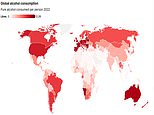Health
Alcohol Consumption Declines in Western Europe, Rises in Asia

Alcohol consumption has significantly decreased in **Western Europe**, particularly in countries like the **United Kingdom**, **Ireland**, **France**, and **Germany**. Since the beginning of the millennium, alcohol intake in Britain has dropped by **10 percent**, with the average adult consuming **10.11 litres** of pure alcohol per year. This decline reflects a broader trend across various age groups, challenging the notion that only younger generations are moving away from drinking.
Data from the **World Health Organization (WHO)** reveals that this decrease is part of a larger pattern in high-income countries. In the UK, alcohol consumption has fallen from **11.18 litres** per adult in **2000**, which ranked the nation **9th** globally, to its current **25th** position. Other countries, such as **Ireland** with a **29 percent** drop, **France** at **25 percent**, and **Germany** at **16 percent**, have experienced even steeper declines.
Changing Attitudes Towards Alcohol
Experts attribute this shift to evolving social attitudes and increased awareness of the harmful effects of alcohol. **Dr. Melissa Oldham** from **University College London** notes that the trend is evident in many affluent nations, driven by changing social dynamics among younger people. She states, “Declining youth alcohol consumption is something we are seeing across many high-income countries.” This change is marked by a preference for healthier lifestyles, fitness consciousness, and financial considerations, with younger generations often opting for low or non-alcoholic alternatives.
The WHO’s survey of **187 countries** indicates that **92** of them consumed less alcohol in **2022**. Notably, **Syria** reported the largest decrease at **93 percent**, albeit from a low starting point. Other countries, such as **Venezuela**, saw a **74 percent** drop in consumption.
Conversely, alcohol consumption has surged in certain regions, especially in parts of **Southeast Asia**. In **Cambodia**, for instance, alcohol intake has skyrocketed nearly **seven-fold**, with significant increases also observed in **Myanmar** and **Vietnam**. This rise is largely attributed to economic growth and an expanding middle class that can afford greater access to alcohol.
The Impact of Changing Consumption Patterns
The rising popularity of low and non-alcoholic beverages reflects changing consumer preferences. In the UK, wine consumption has increased dramatically since the **1960s**, influenced in part by higher drinking rates among women. In contrast, beer consumption has more than halved, declining from **276 pints** per adult annually to **110 pints**.
Despite the reduction in overall consumption, the UK is grappling with a public health crisis linked to alcohol misuse. Alcohol-related deaths reached a record high in **2023**, with nearly **10,500** fatalities, marking a **20 percent** increase since the pandemic began. **Dr. Richard Piper**, CEO of **Alcohol Change UK**, describes this as a “slow-burning crisis,” emphasizing the need for a comprehensive approach to tackle the growing health risks associated with alcohol.
Campaigners advocate for measures such as minimum unit pricing and stricter advertising regulations to curb alcohol-related harm. **Dr. Piper** suggests that implementing minimum unit pricing, which is already in place in **Scotland** and **Wales**, could help reduce the accessibility of cheap, high-strength drinks.
The rise of the low and no-alcohol sector is transforming the drinking landscape. According to the **IWSR**, a drinks analytics consultancy, this market is expected to grow significantly over the next few years, with projected revenues exceeding **£3 billion** by **2028**. Initiatives like “Dry January,” which encourages abstention from alcohol for the month, have gained traction, with participation tripling since **2019**.
In summary, the decline in alcohol consumption in Western Europe reflects a profound shift in societal attitudes towards drinking. As younger generations embrace healthier lifestyles and alternative beverages, the alcohol industry is facing substantial challenges in adapting to these changing consumer preferences.
-

 Entertainment2 months ago
Entertainment2 months agoIconic 90s TV Show House Hits Market for £1.1 Million
-

 Lifestyle4 months ago
Lifestyle4 months agoMilk Bank Urges Mothers to Donate for Premature Babies’ Health
-

 Sports3 months ago
Sports3 months agoAlessia Russo Signs Long-Term Deal with Arsenal Ahead of WSL Season
-

 Lifestyle4 months ago
Lifestyle4 months agoShoppers Flock to Discounted Neck Pillow on Amazon for Travel Comfort
-

 Politics4 months ago
Politics4 months agoMuseums Body Critiques EHRC Proposals on Gender Facilities
-

 Business4 months ago
Business4 months agoTrump Visits Europe: Business, Politics, or Leisure?
-

 Lifestyle4 months ago
Lifestyle4 months agoJapanese Teen Sorato Shimizu Breaks U18 100m Record in 10 Seconds
-

 Politics4 months ago
Politics4 months agoCouple Shares Inspiring Love Story Defying Height Stereotypes
-

 World4 months ago
World4 months agoAnglian Water Raises Concerns Over Proposed AI Data Centre
-

 Sports4 months ago
Sports4 months agoBournemouth Dominates Everton with 3-0 Victory in Premier League Summer Series
-

 World4 months ago
World4 months agoWreckage of Missing Russian Passenger Plane Discovered in Flames
-

 Lifestyle4 months ago
Lifestyle4 months agoShoppers Rave About Roman’s £42 Midi Dress, Calling It ‘Elegant’









